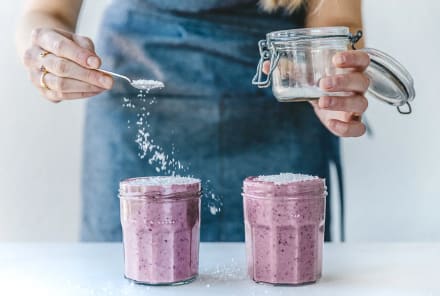Advertisement
9 Ingredients That Should Never Be In Your Protein Powder

If you’re busy, protein powders can often come in handy. At any time of day, you can quickly whip up a shake and allow your body to be nourished and satisfied.
A quality protein drink made with nutrient-dense ingredients (and lots of whole foods) can benefit your health in a number of ways. Protein is an essential macronutrient with many critical roles in health, from metabolism and hormone production to immunity, to name a few. Protein is also a key nutrient for healthy skin and lean, toned muscles.
I’ve been in the fitness and health industry since my early 20s and have tasted many kinds of protein powders on the market. Some made me gain weight, some constipated me for days, and some made me feel bloated.
It’s important you choose the right protein powder that suits your needs and that supports your nutritional needs and overall health.
Protein:
- Is made of long chains of amino acid building blocks
- Is found in all cells of the body as the major structural and functional component
- Is what hormones, enzymes, antibodies, signaling molecules, collagen, etc. are all made of
- Provides essential nutrition throughout all stages of life for growth, repair, and maintenance
- Daily needs (grams of protein per kilogram of body weight) are highest during infancy and lowest during adulthood, but then increase during pregnancy and lactation
- Supports metabolism and a healthy weight and body composition
- Is an important component of detox and elimination diets
- Helps repair and maintain healthy skin, hair, and nails
- Contributes to blood sugar stability
- Helps control appetite
- Is important for metabolic health
- Is critical for maintaining a strong immune system
- Sustains lean muscle mass and protects from muscle loss
- Helps us recover after exercise or during an illness
In my opinion, here’s what you DON'T want in a protein powder:
1. Casein and WPC
These are also known as caseinate and whey protein concentrate. WPC’s and casein dairy-derived protein sources are high in the sugar lactose, which can cause bloating, flatulence, and gastrointestinal distress in some people, particularly those with lactose intolerance1.
If you’re looking for a whey protein product, whey isolate and hydrolysate options have lower carb and fat than WPC, so they are better options in the whey universe for folks with lactose issues.
2. Gluten
Food sensitivities to gluten2 can trigger an immune-mediated response in the gut that results in inflammation. This causes gastrointestinal distress in some people and may contribute to a range of health problems including hormonal imbalances, skin conditions, fatigue, mood swings, and headaches.
3. Dextrin and Glucose
Dextrin is typically a way to increase fiber content in products but can cause gastrointestinal distress in some people due to its low digestibility. It’s derived from wheat or corn (most of which is genetically modified) and is made up of polymers of glucose.
In contrast, added sugars that digest quickly and deliver glucose to your bloodstream raise your glycemic load, which can translate into insulin spiking, excess fat storage, and worse cardiometabolic health over time.
4. Artificial sweeteners
Common artificial sweeteners used are sucralose (Splenda), aspartame (Equal, NutraSweet), saccharin (Sweet'N Low), neotame (Newtame), and acesulfame K (Sunett, Sweet One). Aside from being unnatural chemicals, some people experience negative effects, from headaches and gastric distress, to mood issues and weight gain.
5. Skim milk powders/milk solids
Skim milk powders and milk solids are often used as a cheap bulking agent in lower quality powders. They are high in lactose sugars, which can cause bloating, gastrointestinal distress, flatulence, constipation, and loose stools in some.
6. Soy protein
While soy is a complete protein from a plant source, much of the soy is genetically modified and can be exposed to pesticides. Soy also naturally contains isoflavones, which are phytoestrogen compounds3 that mimic estrogen. While phytoestrogens have demonstrated benefits from bone health to heart disease, they can also function as endocrine disruptors and cause hormonal disturbances in some people.
7. Vegetable oils and fats
These ingredients are often added to many weight loss and protein supplements to increase richness. However, these fats are often derived from processed, hydrogenated sources that contain trans fats, which are thought to be more harmful than saturated fats.
Specifically, trans fats raise levels of triglycerides and bad (LDL) cholesterol, while lowering good (HDL) cholesterol. This dyslipidemia is a recipe for metabolic dysfunction4. Furthermore, vegetable oils are often high in omega-6 fatty acids, which are plentiful in our diet. In contrast, most of us need more omega-3 fats.
8. Thickeners and gums
Thickening agents and gums, including xanthan gum, are often manufactured from soy, corn, and wheat. These added ingredients can cause bloating and gas in some people.
9. Fillers
Fillers are often added to bulk up the protein and save money for the manufacturer. Some fillers may include ingredients such as coconut flour or psyllium fiber, which can cause gastrointestinal discomfort in those who are susceptible to digestive issues, such as constipation or bloating.
The less ingredients the better!
When should protein shakes be incorporated into a diet?
Match your protein to your goal. If you find a clean protein powder, it can be used for a number of things, such as fitness, weight management, healthy snack, etc. However, you will use the protein differently depending on what your goal is.
1. Weight loss
Protein can work effectively to help regulate the appetite5 (less hunger, more satiety), build lean muscle6, and support weight loss7. It is recommended you get 1.2 to 1.6 grams per kilogram body weight per day (or at least 25 to 30 grams of protein per meal) to support these outcomes7. For a 145-pound woman, that would be about 80 to 105 grams of protein per day.
The best, science-backed way to use protein for weight loss is to use it as a meal replacement8. Start the day with a morning smoothie for breakfast after your workout.
I use grass-fed whey protein or organic pea protein, and then add frozen berries, almond milk or coconut water, and some ice. A small banana can also be added for extra creaminess, and you can be creative with personalized boosters like matcha green tea. This type of smoothie will support your metabolism, nourish lean muscle, and deliver nutrient-dense energy for your day ahead.
As a midafternoon snack, I like to combine 1 serving of protein powder with 1-½ cups of coconut water or water in a blender bottle. This will help curb your appetite and keep you from reaching for the cookie jar when you feel like something sweet.
2. Sports performance
A smart time to consume protein is after you exercise. This is when blood flow to the exercised muscles is high and is especially receptive to nutrients, with protein synthesis rates up9.
Before exercising, protein shakes can curb appetite and help keep blood sugars stable to get you through your workout.
It’s important that your protein is high in BCAA’s (branched-chain amino acids). Studies show that these three essential amino acids (leucine, isoleucine, and valine) can increase muscle mass and mitigate its breakdown10, reduce fatigue11, and improve exercise performance12.
For sports performance and recovery, I love to shake my protein with coconut water or water and drink it immediately after my workout. I think that two shakes per day is a great approach to help your body and muscles recover quickly.
Should protein be mixed into a smoothie with fruit? Or are they best taken alone with water?
This depends on whether you want to use protein powder as a healthy meal replacement or just a quick protein fix.
As a smoothie, you’re creating a complete meal with protein, natural carbs (e.g. fruits, almond milk), healthy fats, and the micronutrients and fiber that come along with those additions. That’s why this approach is great for breakfast on the go.
As a protein-centric shake mixed with water, your focus is getting protein into the body. This is great after a workout when your muscles are particularly receptive to the intake of protein.
How much protein should a woman get in her diet?
The amount of protein you consume each day varies slightly depending on your age, weight, and activity level. To maintain good health, it’s all about getting a good balance of quality and complete protein sources over the course of a day.
The current daily requirement for protein intake in adults (0.8 grams per kilo of body weight per day) is not a goal to aim for, because that's a minimum protein amount13 designed to prevent loss of lean body mass.
Instead, aim for at least 1.0 gram of protein per kilo of body weight each day. For a 145-pound person, that’s 66 grams of protein per day. For athletes, pregnant women, breastfeeding moms, or those focused on achieving a healthy weight, aim for at least 1.2 grams of protein per kilo of body weight or about 80 grams per day.
Some women fear bulking up, can this happen?
Aside from genetic makeup, there are a few other explanations as to why some women bulk up or gain weight when supplementing with protein powder .
They could be exercising incorrectly for their body type and needs, eating too much (all macros in excess are converted to fat) overall or eating the wrong foods, or drinking too much alcohol, which contributes additional calories and can have negative effects on lipid metabolism and fat accumulation14.
Other women choose a no-carb diet and focus on getting lots of protein. What are the dangers with this?
A no-carb or very-low-carb diet isn't sustainable. Aside from carbs being an essential macronutrient and important daily energy source, carb elimination can cause fatigue, digestive issues, constipation, headaches, mood swings, inadequate fiber intake, and a variety of micronutrient deficiencies.
Instead, focus on including the healthy carbs into your diet, like fresh fruits, vegetables, legumes, and whole grains. You’ll feel nourished and vitalized, and your body and skin will thank you!
Is plant-based protein inferior to animal-based protein? Why/why not?
Plant-based protein isn't inferior, as long as you choose one or ones (a combination) that have a complete amino acid profile and are not loaded with fillers, or the other unhealthy ingredients listed above. The less ingredients the better!
Evaluate the ingredient quality and how it’s made. Like most manufactured foods, protein powders are not created equal. It's important that the protein you use is un-denatured and free from unhealthy chemicals and additives.
14 Sources
- https://www.ncbi.nlm.nih.gov/books/NBK532285/
- https://www.ncbi.nlm.nih.gov/pmc/articles/PMC6630947/
- https://www.ncbi.nlm.nih.gov/pmc/articles/PMC3074428/
- https://www.ncbi.nlm.nih.gov/pmc/articles/PMC2639783/
- https://www.ncbi.nlm.nih.gov/pmc/articles/PMC4190484/
- https://pubmed.ncbi.nlm.nih.gov/25169440/
- https://pubmed.ncbi.nlm.nih.gov/25926512/
- https://www.ncbi.nlm.nih.gov/pmc/articles/PMC6849863/
- https://www.ncbi.nlm.nih.gov/pmc/articles/PMC5852800/
- https://www.ncbi.nlm.nih.gov/pmc/articles/PMC5691664/
- https://www.ncbi.nlm.nih.gov/pmc/articles/PMC7126259/
- https://www.ncbi.nlm.nih.gov/pmc/articles/PMC6971972/
- https://www.ncbi.nlm.nih.gov/pmc/articles/PMC6566799/
- https://www.ncbi.nlm.nih.gov/pmc/articles/PMC5372728/
Watch Next
Enjoy some of our favorite clips from classes
Enjoy some of our favorite clips from classes
What Is Meditation?
Mindfulness/Spirituality | Light Watkins
Box Breathing
Mindfulness/Spirituality | Gwen Dittmar
What Breathwork Can Address
Mindfulness/Spirituality | Gwen Dittmar
The 8 Limbs of Yoga - What is Asana?
Yoga | Caley Alyssa
Two Standing Postures to Open Up Tight Hips
Yoga | Caley Alyssa
How Plants Can Optimize Athletic Performance
Nutrition | Rich Roll
What to Eat Before a Workout
Nutrition | Rich Roll
How Ayurveda Helps Us Navigate Modern Life
Nutrition | Sahara Rose
Messages About Love & Relationships
Love & Relationships | Esther Perel
Love Languages
Love & Relationships | Esther Perel
What Is Meditation?
Box Breathing
What Breathwork Can Address
The 8 Limbs of Yoga - What is Asana?
Two Standing Postures to Open Up Tight Hips
How Plants Can Optimize Athletic Performance
What to Eat Before a Workout
How Ayurveda Helps Us Navigate Modern Life
Messages About Love & Relationships
Love Languages
Advertisement

Green Tea vs Black Tea: Caffeine, Health Benefits & When To Sip Each
Jillian Kubala, M.S., R.D.











